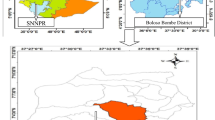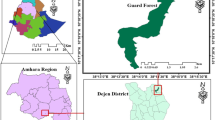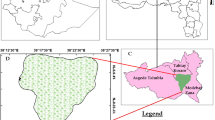Abstract
Floristic composition and vegetation structure were described for the woodland vegetation around Dello Menna, Bale zone, southeast Ethiopia. A total 50 (20 m × 20 m) quadrats were sampled to identify and describe plant community types, species diversity, richness and evenness and to relate the identified plant community types with some environmental factors and describe the population structure of woody plant species. In each quadrat, data on species identity, abundance, height and Diameter at Breast Height (DBH) of woody plant species, altitude and slope were recorded. Vegetation classification was performed using PC — ORD software package. Sorensen’s similarity coefficient was used to detect dissimilarities among communities. Shannon — Wiener diversity index, species richness and Shannon’s evenness were computed to describe species diversity of the plant community types. Results show that a total of 171 vascular plant species representing 53 families were recorded. Fabaceae is the dominant family represented by 13 genera and 26 species (15%) followed by Asteraceae, Lamiaceae and Anacardiaceae with eight species each (4.6%). Based on the results of vegetation classification, three plant communities (Dalbergia microphylla community, Grewia bicolar- Acacia brevispica community, and Combretum molle-Combretum collinum community) are recognized and described. Species richness, diversity and evenness varied among the plant communities. Species richness and diversity exhibit a bell — shaped pattern along altitude. Species turn over among communities more or less follow altitudinal gradients. Tukey’s pairwise comparison of means among the plant community types shows significant variations in altitude, implying that altitude is one of the most important factors determining the distribution of plant communities. The community Dalbergia microphylla type exhibits the highest species richness and diversity. Analysis of population structure of the dominant species reveals various patterns. Future research directions and recommendations are suggested for the sustainable utilization of the vegetation.
Similar content being viewed by others
References
Abate A, Tamrat B, Sebsebe D. 2006. The undifferentiated afromontane forest of Denkoro in the central highland of Ethiopia: A floristic and structural analysis. Ethiop J Sci, 29: 45–56.
Anteneh B. 2006. Floristic Description and Ethnobotanical Study of the Natural Vegetation in the Babile Elephant Sanctuary, Ethiopia. MSc. Thesis. AAU, Addis Ababa.
Bhattarai KR, Vetaas OR. 2003. Variation in plant species richness of different life forms along a subtropical elevation gradient in the Himalayas, east Nepal. Glob Ecol Biogeog, 12: 327–340.
Brinkmann K, Patzelt A, Dickhoefer U, Schlecht E, Buerkert A. 2009. Vegetation patterns and diversity along an altitudinal and a grazing gradient in the Jabal al Akhdar mountain range of northern Oman. J Ari Env, 73: 1035–1045.
Brown JH. 2001. Mammals on mountainsides: elevational patterns of diversity. Glob Ecol Biogeog, 10: 101–109.
Daniel G. 1977. Aspects of Climate and Water budget in Ethiopia. A technical Monograph. Addis Ababa University. 39p.
Demel T. 1992. Human impact on a natural montane forest in southeastern Ethiopia. Mount Res Dev, 12: 393–400.
Demel T. 2005. Seed and regeneration ecology in dry Afromontane forests of Ethiopia: I. Seed production — population structures. J Trop Ecol, 46:29–44.
Desalegn W, Zerihun W. 2005. Vegetation of Chencha highlands in southern Ethiopia. Ethiop J Sci, 28: 109–118.
Dufrene M, Legendre P. 1997. Species assemblages and indicator species: the need for a flexible asymmetrical approach. Ecol Mono, 67: 345–366.
Edwards S, Mesfin T, Hedberg I. 1995. Flora of Ethiopia and Eritrea, Vol. 2(2). The National Herbarium, Addis Ababa.
Edwards S, Mesfin T, Sebsebe D, Hedberg I. 2000. Flora of Ethiopia and Eritrea, Vol. 2(1). The National Herbarium, Addis Ababa.
Edwards S, Sebsebe D, Hedberg I. 1997. Flora of Ethiopia and Eritrea, Vol. 6. The National Herbarium, Addis Ababa.
Ermias L, Ensermu K, Tamrat B, Haile Y. 2008. Plant species composition and structure of the Mana Angetu mosit montane forest, south-eastern Ethiopia. J East Afrc Natur hist, 97(2): 165–185.
EWNHS (Ethiopian Wildlife and Natural History Society). 1996. Important Bird Areas of Ethiopia. A First Inventory. EWNHS, Addis Ababa.
Feyera S, and Denich M. 2006. Effects of wild coffee management on species diversity in the Afromontane rainforests of Ethiopia. For Ecol Manage, 232: 68–74.
Feyera S. 2006. Biodiversity and Ecology of Afromontane Rainforests with Wild Coffea arabica L. Populations in Ethiopia. Ecology and Development Series No. 38. Center for Development Research, University of Bonn.
Gemedo D. 2004. Vegetation Ecology, Rangeland Condition and Forage Resources Evaluation in the Borana Lowlands, Southern Oromia, Ethiopia. Doctoral Dissertation. Georg-August University, Göttingen.
Getachew T, Tamrat B, Sebsebe D. 2008. Dryland woody vegetation along an altitudinal gradient on the eastern escarpment of Welo, Ethiopia. Ethiop J Sci, 31: 43–54.
Grytnes JA, Vetaas OR. 2002. Species Richness and Altitude: A comparison between Null Models and Interpolated Plant Species Richness along the Himalan Altitudinal Gradient, Nepal. The American Natural, 159: 294–304.
Haile Y, Ensermu K, Tamrat B, Ermias L. 2008. Floristic composition and structure of the dry afromontane forest at Bale Mountains National Park, Ethiopia. Ethiop J Sci, 31: 103–120.
Hedberg I, Edwards S, Sileshi N. 2003. Flora of Ethiopia and Eritrea, Vol. 4(1). The National Herbarium, Addis Ababa.
Hedberg I, Edwards S. 1989. Flora of Ethiopia, Vol. 3. The National Herbarium, Addis Ababa.
Hedberg I, Edwards S. 1995. Flora of Ethiopia and Eritrea, Vol. 7. The National Herbarium, Addis Ababa.
Hedberg I, Ensermu K, Edwards S, Sebsebe D, Persson E. 2006. Flora of Ethiopia and Eritrea, Vol. 5. The National Herbarium, Addis Ababa.
Hedberg I, Friis I, Edwards S. 2004. Flora of Ethiopia and Eritrea, Vol. 4(2). The National Herbarium, Addis Ababa.
Hegazy AK, Lovett-Doust J, Hammouda O, Gomaa NH. 2007. Vegetation distribution along the altitudinal gradient in the northwestern Red Sea region. Comm Ecol, 8: 151–162.
Kent M, Coker P. 1992. Vegetation Description and Analysis. A practical approach. New York: John Wiley and Sons, 363p.
Kitessa H, Tamrat B, Ensermu K. 2007. Floristic and phytogeographic synopsis of a dry Afromontane coniferous forest in the Bale Mountains (Ethiopia): implications to biodiversity conservation. Ethiop J Sci. 30:1–12.
Krebs CJ. 1999. Ecological Methodology. Second edition. Addison-Welsey Educational publishers. Inc.
Kumelachew Y, Tamrat B. 2002. Plant community analysis and ecology of Afromontane and transitional rainforest vegetation of southwestern Ethiopia. Ethiop J Sci, 25:155–175.
Lisanework N, Mesfin T. 1989. An Ecological study of the vegetation of the Harenna forest, Bale, Ethiopia. Ethiop J Sci, 12: 63–93.
McCune B, Mefford MJ. 1999. PC-ORD. Multivariate Analysis of Ecological Data.Version 4.20. MjM software, Gleneden Beach, Oregon, USA.
Minassie G, Masresha F. 1996. Plant communities of the Afroalpine vegetation of Sanetti plateau, Bale Mountains, Ethiopia. Ethiop J Sci, 19: 65–86.
Mueller-Dombois D, Ellenberg H. 1974. Aims and Methods of Vegetation Ecology. Wiley and Sons, New York, 547 pp.
Negusse T. 2006. Ecology and Plant Use Diversity in Sof Umer area of Bale, Southeastern Ethiopia. MSc. Thesis. AAU, Addis Ababa.
Sánchez-González A, López-Mata L. 2005. Plant species richness and diversity along an altitudinal gradient in the Sierra Nevada, Mexico. Diversity Distrib, 11: 567–575.
Sebsebe D, Nordal I, Stabbetorp OE. 2003. Flowers of Ethiopia and Eritrea. Aloes and other Lilies. First edition. Shama Books, Addis Ababa. 227p.
Simon S, Zerihun W. 2006. Comparative floristic study on Mt. Alutu and Mt. Chubbi along an altitudinal gradient. J Drylan, 1(1): 8–14.
Tadesse WG, Borsch T, Denich M, Demel T. 2008. Floristic composition and environmental factors characterizing coffee forests in southwest Ethiopia. For Ecol Manage, 255: 2138–2150.
Tadesse WG, Demel T. 2001. The forest coffee ecosystems: Ongoing crises, problems and opportunities for coffee gene conservation and sustainable utilization. In: Imperative problems associated with forestry in Ethiopia, pp. 131–142. Workshop proceedings. Biological Society of Ethiopia, Addis Ababa.
Tadesse WG, Denich M, Demel T. 2002. Human impacts on the Coffea arabica gene pool in Ethiopia and the need for its in situ conservation. In: Engels, J.M.M., Rao, V.R., Brown, A.H.D. and Jackson, M.T. (eds), Managing Plant genetic Diversity, pp. 237–247, CAB International, USA.
Tadesse WG. 2003. Vegetation of the Yayu forest in Southwest Ethiopia: Impacts of human use and Implications for In situ conservation of Wild Coffea arabica L. populations. Ecology and Development Series No. 10. Center for Development Research, University of Bonn.
Tamrat A. 2001. Floristic Composition and Ecology of the Savannah Grassland and Woodland Vegetation in Nechisar National Park and Its Conservation Status. MSc. Thesis. AAU, Addis Ababa.
Tamrat B. 1994. Phytosociology and ecology of a humid Afromontane forest on the central plateau of Ethiopia. J Veg Sc, 5: 87–98.
Tesfaye A, Tamrat B, Sebsebe D. 2001. An ecological study of the vegetation of Gambella region, Southwestern Ethiopia. Ethiop J Sci, 24: 213–228.
Teshome S, Demel T, Sebsebe D. 2004. Ecological study of the vegetation in Gamo Gofa zone, southern Ethiopia. J Tro Ecol, 45: 209–221.
Teshome T. 2006. Study of Woody Plant Species Diversity and Socioeconomic Importance of Boke Salt House, A volcanic Crater Lake, in Semiarid Drylands of Borana, Southern Ethiopia. MSc. Thesis. AAU, Addis Ababa.
Vivero JL, Ensermu K, Sebesebe D. 2005. The Red list of Endemic Trees and Shrubs of Ethiopia and Eritrea. Fauna and Flora International, Cambridge, UK, 23p.
Watkins JR, CardelÚs C, Colwell RK, Moran RC. 2006. Species richness and distribution of ferns along an elevational gradient in Costa Rica. Amer J Bot, 93: 73–83.
Zerihun W, Feoli E, Lisanework N. 1989. Partitioning an elevational gradient of vegetation from southeastern Ethiopia by probabilistic methods. Vegetatio, 81: 189–198.
Zerihun W. 1999. Forests in the vegetation types of Ethiopia and their status in the geographical context. In: Edwards, S., Abebe Demmissie, Taye Bekele and Haase, G. (eds), Forest Genetic Resources Conservation: Principles, Strategies and Actions, pp. 1–38. Institute of Biodiversity Conservation and Research and GTZ, Addis Ababa.
Author information
Authors and Affiliations
Corresponding author
Additional information
Foundation project: This work was supported by The Canadian International Development Agency (CIDA), Sinana Agricultural Research Center (SARC)
Rights and permissions
About this article
Cite this article
Didita, M., Nemomissa, S. & Gole, T.W. Floristic and structural analysis of the woodland vegetation around Dello Menna, southeast Ethiopia. Journal of Forestry Research 21, 395–408 (2010). https://doi.org/10.1007/s11676-010-0089-9
Received:
Accepted:
Published:
Issue Date:
DOI: https://doi.org/10.1007/s11676-010-0089-9




